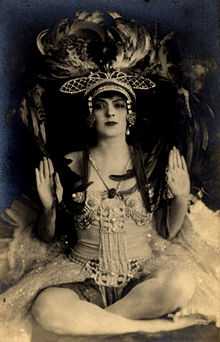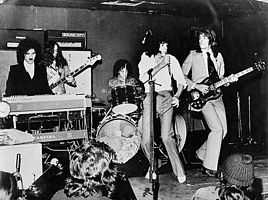The Pheasantry
The Pheasantry, 152 King's Road, Chelsea, London, is a Grade II listed building[1] that was home to a number of important figures in 1960s London and a small music venue in the 1970s where a number of bands were able to play their first gigs.
Early history
The original buildings, now largely demolished, may have been constructed in 1766[2] or 1769.[3] The site gets its name from the business of Samuel Baker who developed new breeds of oriental pheasants as well as cattle and foxes. Advertising appeared in The Field in 1865 offering pairs of birds for 15 guineas.[2]
Amédée Joubert & Son
English Heritage believe that the current building was constructed in the mid-nineteenth century.[1] The Companion Guide to London states that the Jouberts bought the building in 1880[2] and it seems that they added significant amounts of architectural decoration around that time. According to Nikolaus Pevsner and Bridget Cherry, the building includes a "flamboyant Louis XV façade and a triumphal entrance arch to its front courtyard with caryatids and quadringa ... the odd, extremely heavy display of Grecian enthusiasm were added to an earlier house in 1881 by the artist and interior decorator Amédée Joubert".[4] The London Green Guide noted in 2012 that only the facade and portico survive.[5]
The firm of Amédée Joubert & Son provided services of upholstery, gilding, the importation of Aubusson tapestry, Lyons silks and oriental carpets and the manufacture of French bedding, chairs etc and continued until 1932, lastly under Felix Joubert who also made dolls' house furniture for Queen Mary.[6] By 1914, however, the showroom was closed and the rest of the building rented out as studios with only the basement in use by the Jouberts as a workshop.[7]
Pheasantry studios

In the early 1900s, one occupant of the Pheasantry was Eleanor Thornton (drowned 1915), a favourite model of artist and sculptor Charles Sykes. Thornton may have been the model for Sykes' most famous work, his Rolls Royce mascot the Spirit of Ecstasy.[8]
From 1916, part of the building was a ballet academy run by the dance teacher Serafina Astafieva (1876-1934), great niece of Leo Tolstoy.[3] Astafieva trained Alicia Markova who came to Diaghilev's attention when he visited the school in 1921[9] and went on to join his Ballets Russes. Anton Dolin and Margot Fonteyn also trained there.[10]
From 1950, the Italian painter Pietro Annigoni spent six months a year in Britain[11] using the Pheasantry as his British studio.[12]
The Pheasantry Club
Following the retirement of Felix Joubert in 1932,[7][13] the basement became a bohemian restaurant and drinking club patronised by actors and artists,[3] including Augustus John, Dylan Thomas, Humphrey Bogart, and Francis Bacon.[13] It was run by an Italian called Reny De Meo.[13] Lynda Bellingham recalls that in the 1960s Anthony Hopkins would "hold court" there doing an impression of Richard Burton doing Dylan Thomas.[14] The club closed in 1966 after the death of the owner Mario Cazzini,[15] and the building was converted into apartments[3] and the basement into a nightclub.
1960s
Among those living at The Pheasantry in the 1960s were David Litvinoff who worked in Tim Whidborne's studio there,[16] the writer Anthony Haden-Guest, the musician Eric Clapton and Martin Sharp of Oz magazine who shared a studio there, Germaine Greer, Robert Whitaker and Nicky Kramer.[17] Clapton only escaped being arrested on drugs charges by Norman Pilcher, who rang the doorbell to announce "postman, special delivery", by escaping from the rear of the building.[3] By this time, the building was starting to deteriorate. One visitor, Mick Farren, recalled: "It was falling down. It had gone through its popular phase, but no money had been put back into it to fix the roof and stuff, and the roofs were leaking and everything was kind of coming apart".[17]
The sound from the nightclub in the basement could be heard through the floorboards in the studios above. The club had seen better days. Barry Miles recalls it as a venue where "the likelihood of having your drink spiked with acid was pretty high". Another said: "It would be an R & B club for a bit ... then it'd become a gay club for a while ... [it] always seemed to be hosting various floating crap games, some of which were R & B, some of which were folk music and some of which were gay. I think also it had a back room where the doors were closed and people went on drinking, and I think there were gangsters involved."[17]
According to Miles, one King's Road character who lived at the Pheasantry had a pet rabbit, which he dyed bright green and may have given acid to, that "committed suicide" by leaping from the roof. Miles said: "He was a fucking mad idiot. I mean, there were a lot of people like that, particularly at the Pheasantry, it was really filled with them."[18]
1970s

The Pheasantry nightclub hosted early gigs by Lou Reed, Queen and Hawkwind. The venue was small, however, and nobody remembers it with affection. It was a place that you went to if you were unknown. According to John Hewlett, "It was a naff place to play. It was the sort of place you played if you get the The Marquee."[19] It was a gig in London, however, and unsigned bands were grateful for that.[19] The 1972 gig by Queen, which had been intended as a showcase for the band, did not go well. Phil Reed remembered that the band were "unpolished" and the venue was mainly a disco, "once the disco had stopped and Queen went on everyone went to the bar."[20] In addition, none of the record company A & R people who had been invited, turned up.[20] Thin Lizzy performed there and were described as "playing to a handful of posey people sitting there drinking cocktails."[21]
Andrew Lloyd Webber and Tim Rice found Yvonne Elliman at the Pheasantry, as a result of which she featured in the original soundtrack of Jesus Christ Superstar.[22] Sparks played their first British gig there.[19]
In the 1970s John Betjeman led a campaign to prevent the redevelopment of the site.[22][23]
Today
The building now houses a branch of the Pizza Express restaurant chain.[24] In the basement is a cabaret club The Pheasantry which opened in 2010 after the closure of Pizza on the Park.[25]
References
- ↑ 1.0 1.1 THE PHEASANTRY English Heritage. Retrieved 15 August 2014.
- ↑ 2.0 2.1 2.2 Piper, David. (2000). The Companion Guide to London (9th revised ed.). Woodbridge: Companion Guides. p. 199. ISBN 978-1-900639-36-1.
- ↑ 3.0 3.1 3.2 3.3 3.4 Glinert, Ed. (2012). The London Compendium: A Street-by-street Exploration of the Hidden Metropolis. London: Penguin. p. 1001. ISBN 978-0-7181-9204-4.
- ↑ Pevsner, Nikolaus & Bridget Cherry. (2002) London 3: North West. Reprint. New Haven: Yale University Press. ISBN 0300096526
- ↑ Michelin. (2012). London Green Guide Michelin 2012-2013. London: Michelin. p. 213. ISBN 978-2-06-718238-7.
- ↑ The Electric Theatre cinema adjacent at 148-50 King's Road was designed by Felix in 1912.
- ↑ 7.0 7.1 "Economic history: Trade and industry" in A History of the County of Middlesex: Volume 12: Chelsea. (2004) pp. 156-165. www.british-history.ac.uk Retrieved 27 September 2014.
- ↑ Wings of desire: the secret love affair that inspired Rolls-Royce's flying lady. Chris Hastings, The Telegraph, 20 April 2008. Retrieved 27 September 2014.
- ↑ Decharne, Max. (2005) King's Road: The Rise and Fall of the Hippest Street in the World. London: Weidenfeld & Nicolson, p. 23. ISBN 0297847694
- ↑ Decharne, 2005, p. 23.
- ↑ "ANNIGONI, Pietro." Benezit Dictionary of Artists. Oxford Art Online. Oxford University Press. Retrieved 27 September 2014. (subscription required)
- ↑ Pearson, John. (2013). The Cult of Violence: The Untold Story of the Krays. London: Bloomsbury Publishing. p. 73. ISBN 978-1-4482-1152-4.
- ↑ 13.0 13.1 13.2 Decharne, 2005, p. 29.
- ↑ Bellingham, Lynda (2011). Lost and Found: My Story. London: Ebury Press. p. 53. ISBN 978-0-09-193641-9.
- ↑ The Princess at the Pheasantry. Dave Walker, The Library Time Machine, 27 June 2013. Retrieved 17 August 2014.
- ↑ Martin Sharp, Greg Weight, MILESAGO. Retrieved 15 August 2014. Originally published in Australian Artist.
- ↑ 17.0 17.1 17.2 Decharne, 2005, pp. 201-202.
- ↑ Decharne, 2005, pp. 202-203.
- ↑ 19.0 19.1 19.2 Easlea, Daryl. (2010). Talent Is An Asset: The Story Of Sparks. London: Omnibus Press. p. 70. ISBN 978-0-85712-237-7.
- ↑ 20.0 20.1 Hodkinson, Mark. (2004). Queen: The Early Years. London: Omnibus Press. p. 152. ISBN 978-1-84449-012-7.
- ↑ Putterford, Mark. (2010). Phil Lynott: The Rocker. London: Omnibus Press. p. 63. ISBN 978-0-85712-254-4.
- ↑ 22.0 22.1 The Pheasantry The Shady Old Lady's Guide to London, 2014. Retrieved 16 August 2014.
- ↑ "Settlement and building: Twentieth century: after the second world war" in A History of the County of Middlesex: Volume 12: Chelsea. (2004) pp. 91-101. www.british-history.ac.uk Retrieved 27 September 2014.
- ↑ Pizza Express: PizzaExpress London - Kings Road Italian Restaurant, Retrieved 16 August 2014
- ↑ New cabaret venue launches in west London The Stage, 21 May 2010. Retrieved 16 August 2014.
Further reading
- Macdonald, Nesta. (1977) The History of the Pheasantry, Chelsea, 1766-1977. London: Nesta Macdonald. ISBN 0950560502
External links
| Wikimedia Commons has media related to The Pheasantry, London. |